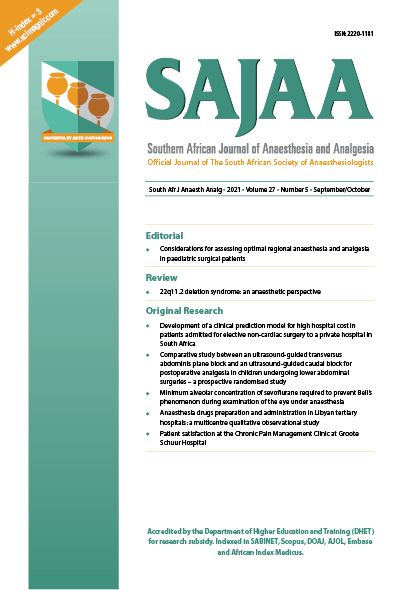Comparative study between an ultrasound-guided transversus abdominis plane block and an ultrasound-guided caudal block for postoperative analgesia in children undergoing lower abdominal surgeries – a prospective randomised study
Keywords:
transversus abdominis plane block, caudal block, postoperative analgesia, paediatric anaesthesiaAbstract
Background: Ultrasound imaging techniques have gained great popularity in anaesthesia during the last decade. We aimed to compare an ultrasound-guided transversus abdominis plane (TAP) block and an ultrasound-guided caudal block for postoperative analgesia in children undergoing lower abdominal surgeries.
Methods: This study randomly allocated 62 children to two groups of 31 children each. One group received a caudal block with 0.25% bupivacaine 0.5 ml/kg with 1 μg/kg dexmedetomidine while the other group received a TAP block with 0.25% bupivacaine 0.5 ml/kg with 1 μg/kg dexmedetomidine. The parameters that were compared were the duration of postoperative analgesia, cumulative dose of rescue analgesic consumed, FLACC pain scores postoperatively, intraoperative and postoperative haemodynamic changes and incidence of side effects.
Results: The duration of analgesia was comparable between the two groups, with 6.61 ± 0.76 hours for the caudal block group and 6.65 ± 0.915 hours for the TAP block group. However, the total amount of cumulative rescue analgesic consumed was significantly higher in the caudal block group (375.8 ± 120.5) compared to the TAP block group (314.5 ± 127.7). The pain scores in 0–6 hours postoperatively were higher in the TAP block group, whereas the caudal block group had higher pain scores 6–24 hours postoperatively with steady rescue analgesic consumption at 8, 12, 16 and 20 hours. Patient-parent satisfaction was better in the TAP block group (7.39 ± 0.76) compared to the caudal block group (6.48 ± 0.811).
Conclusion: The TAP block provided superior analgesia compared to the caudal block, as demonstrated by a statistically significant decrease in the required cumulative rescue analgesic and lower pain scores 6–24 hours postoperatively.
Downloads
Published
Issue
Section
License
By submitting manuscripts to SAJAA, authors of original articles are assigning copyright to the SA Society of Anaesthesiologists. Authors may use their own work after publication without written permission, provided they acknowledge the original source. Individuals and academic institutions may freely copy and distribute articles published in SAJAA for educational and research purposes without obtaining permission.
The work is licensed under a Creative Commons Attribution-Non-Commercial Works 4.0 South Africa License. The SAJAA does not hold itself responsible for statements made by the authors.

